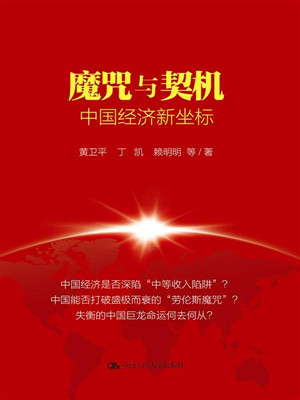New trajectory of the Chinese economy
Author : Zhu Yuqiang Source : Chinese Social Sciences Today 2016-07-07

Curses or Chances: New Coordinates of the Chinese Economy
Author: Huang Weiping, Ding Kai and Lai Mingming
Publisher: Renmin University of China Press
The prevailing interpretation of the current Chinese economy is that it is following an “L” trend that will last for years. There are clear reasons for this economic trajectory, both at home and abroad.
Internationally speaking, the global economic crisis that began in 2008 hit the vast majority of countries. The weak demand from the global economy and a rise in protectionism have decreased the demand for products made in China. According to Curses or Chances: New Coordinates of the Chinese Economy, this phenomenon is the result of global economic imbalances. The book indicates that America’s upgrading of its industrial structure is one reason for the imbalances, arguing that the crisis resulted from a dizzying expansion of the virtual economy caused by the country making real estate and banking businesses the main pillars of the economy, and depending on excessive credit for economic growth.
As for domestic reasons, many analysts have speculated that the “Four Trillion Yuan” plan, a stimulus measure by the Chinese government in 2008 that was used to boost the economy and domestic demand, is still in its initial stages. “Made in China” is located at the low manufacturing end of the “smiling curve” and the government interferes too much in the market. The book stated that the “Four Trillion Yuan” plan was only a temporary solution to Chinese economic problems. It cannot guide the development of the Chinese economy.
Regarding the allocation of resources, over the years the Chinese government has kept saying that it should let the market play a decisive role, but in practice, government interference is still too common. Indeed, the government’s dominance in resource allocation helps to achieve rapid development, but this economic pattern works better when the economy is transitioning from a low-income phase to a middle-income stage. Therefore, the advantages of government dominance will be offset by its weaknesses when the country comes to the high-income stage, where the economic scale expands and the market grows to be more complicated. At present, China is in the transition from the low-income stage to a high-income stage, and we should be careful when using government control while giving play to the “invisible hand” as much as possible.
In 1999, Andrew Lawrence discovered some regularity between skyscrapers and economic cycles, namely, the world’s tallest buildings were erected on the eve of economic downturns. Business cycles and skyscraper construction correlate in such a way that investment in skyscrapers peaks when cyclical growth is exhausted and the economy is ready for recession. This is known as the “Skyscraper Index.” In addition to the “Skyscraper Index,” China and the world economy faces all kinds of similar whimsical concepts such as “middle-income trap” and “ the Tocqueville paradox.” In the 60 years that have passed since the Second World War, many developing countries failed to avoid these traps, but if handled properly, developing countries can seize the opportunity to promote further economic development.
Ye Shengtao made Chinese fairy tales from a wilderness
Ye Shengtao (1894–1988) created the first collection of fairy tales in the history of Chinese children’s literature...
-
How northern ethnicities integrated into Chinese nation
2023-09-18
-
Mogao caves
2023-09-12
-
Mogao Grottoes as ‘a place of pilgrimage’
2023-09-12
-
Time-honored architectural traditions in China
2023-08-29
-
Disentangling the civilizational evolution of China
2023-08-28
-
AI ethics in science fiction
2023-08-23














 2011-2013 by www.cssn.cn. All Rights Reserved
2011-2013 by www.cssn.cn. All Rights Reserved